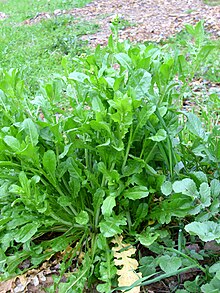Lepidium heterophyllum
| Lepidium heterophyllum | |
|---|---|

| |
| Scientific classification | |
| Kingdom: | Plantae |
| Clade: | Tracheophytes |
| Clade: | Angiosperms |
| Clade: | Eudicots |
| Clade: | Rosids |
| Order: | Brassicales |
| Family: | Brassicaceae |
| Genus: | Lepidium |
| Species: | L. heterophyllum
|
| Binomial name | |
| Lepidium heterophyllum | |
| Synonyms[2] | |
| |
Lepidium heterophyllum, (Smith's cress or Smith's pepperwort), is a species of flowering plant in the mustard family which is native to parts of western Europe, growing in shingle banks, wasteland or cultivated fields.
Description
Lepidium heterophyllum is similar in form to native Lepidium campestre and especially at the early seedling stage, both have been misidentified in Belgium.[3]
It is a
Phytochemistry
It was found after a
It has been used in experiments growing in soils high in copper content, to determine if the plant could be used to help clean contaminated soils. [8]
Taxonomy
It was published and described by George Bentham in 'Cat. Pl. Pyrénées' on page 95 in 1826.[2][4][9]
It has one known subspecies; Lepidium heterophyllum subsp. rifanum (Emb. & Maire) J.M.Monts.[2]
The specific epithet heterophyllum, refers to the Greek for 'different leaves'.[10]
It has a few common names including 'Smith's cress' and 'Smith's pepperwort', It is also known in the US, as 'purple antherfield pepperwort'[12][13][14] The pepperwort name came from plant looking like a 'pepperwort' (Lepidium campestre or other Lepidium species).[5]
Distribution and habitat

Lepidium heterophyllum is
Range
It is found in Europe within Denmark, France, Germany, Ireland, the Netherlands, Portugal, Spain and the United Kingdom.[15]
It is also widely
Habitat
It is found growing in acidic soils,[1][16] on hillsides,[4] in shingle, railway ballast and embankments, and, occasionally, in arable fields.[1][6][16]
It is normally found at altitudes of 0–425 m (0–1,394 ft) above sea level.[1][6][16]
Conservation
Populations of Lepidium heterophyllum currently are stable, but it seems to be decreasing in S.E. England.[16]
References
- ^ . Retrieved 12 November 2021.
- ^ a b c d "Lepidium heterophyllum Benth. is an accepted name". 23 March 2012. theplantlist.org. Retrieved 26 November 2017.
- ^ "Lepidium heterophyllum". alienplantsbelgium.be. 19 July 2012. Retrieved 26 November 2017.
- ^ a b c d e f g h i j k l m "FNA Vol. 7 Page 571, 578, 582, 583". efloras.org. Retrieved 26 November 2017.
- ^ ISBN 9780276002175.
- ^ a b c d e f g h i j k l m n o Simon Harrap Harrap's Wild Flowers (2013), p. 130, at Google Books
- PMID 12481035.
- ^ Irena Twardowska, Herbert E. Allen and Max M. Häggblom (Editors) Soil and Water Pollution Monitoring, Protection and Remediation, p. 193, at Google Books
- ^ a b "Brassicaceae Lepidium heterophyllum Benth". ipni.org. Retrieved 26 November 2017.
- ^ "Myriophyllum heterophyllum Michx". swbiodiversity.org. Retrieved 27 November 2017.
- ^ a b "Lepidium heterophyllum". rhs.org.uk. Retrieved 26 November 2017.
- ^ Tim Johnson CRC Ethnobotany Desk Reference, p. 464, at Google Books
- ^ "purpleanther field pepperweed". invasiveplantatlas.org. Retrieved 29 November 2017.
- ^ Joseph M. DiTomaso and Evelyn A. Healy Weeds of California and Other Western States, Volume 1 (2007), p. 1786, at Google Books
- ^ a b c "Taxon: Lepidium heterophyllum Benth". npgsweb.ars-grin.gov. Retrieved 28 November 2017.
- ^ a b c d e "Lepidium heterophyllum". brc.ac.uk (Biological Records Centre). Retrieved 26 November 2017.
Other sources
- Al-Shehbaz, I. A. 2010. A synopsis of the South American Lepidium (Brassicaceae) (Darwiniana) 48:141-167.
- Botanical Society of the British Isles BSBI taxon database (on-line resource). (BSBI)
- FNA Editorial Committee Flora of North America. 1993- (F NAmer)
- Greuter, W. et al., eds. Med-Checklist. 1984- (L Medit)
- Jalas, J. & J. Suominen Atlas florae europaeae. 1972- (Atlas Eur)
- Tutin, T. G. et al., eds. Flora europaea. 1964-1980 (F Eur)

